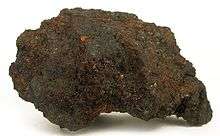Disko Island
| Native name: Qeqertarsuaq | |
|---|---|
|
Qeqertarsuaq town on Disko Island | |
 Disko | |
| Geography | |
| Location | Baffin Bay |
| Coordinates | 69°45′N 53°30′W / 69.750°N 53.500°WCoordinates: 69°45′N 53°30′W / 69.750°N 53.500°W |
| Area | 8,578 km2 (3,312 sq mi) |
| Length | 160 km (99 mi) |
| Highest elevation | 1,919 m (6,296 ft) |
| Administration | |
|
Greenland | |
| Municipality | Qaasuitsup |
| Demographics | |
| Population | 1,100 |
| Ethnic groups | Inuit |
Disko Island (Greenlandic: Qeqertarsuaq, Danish: Diskoøen) is a large island in Baffin Bay, off the west coast of Greenland. It has an area of 8,578 km2 (3,312.0 sq mi),[1] making it the second largest island of Greenland (after the main island of Greenland) and one of the 100 largest islands in the world. The name Qeqertarsuaq means The Large Island (from qeqertaq = island).
Geography
The island has a length of about 160 km (99.4 mi), rising to an average height of 975 m (3,198.8 ft), peaking at 1,919 m (6,295.9 ft). The port of Qeqertarsuaq (named after the island, and also known as Godhavn) lies on its southern coast. Blæsedalen valley is north of Qeqertarsuaq.
The island is separated from Nuussuaq Peninsula in the northeast by the Sullorsuaq Strait. To the south of the island lies Disko Bay, an inlet bay of Baffin Island.[2]
History
Eric the Red paid the first recorded visit to Disko Island at some time between 982 and 985; the island may have been used as a base for summer hunting and fishing by Viking colonists.
Geology

Mineral deposits, fossil finds and geological formations add to interest in the area. One of the interesting geological features is the native iron found at the island. A 22-ton lump mixture of iron and iron carbide (cohenite) has been found. There are only a few places on earth where native iron is found which is not of meteoric origin.[3][4]
There are numerous hot springs on the island. The microscopic animal Limnognathia, the only known member of its phylum, was discovered in these springs.
Biodiversity
Several studies on the meiofauna show high marine interstitial diversity in Disko Island. For instance, the gastrotrich species Diuronotus aspetos is found in Iterdla[5] and Kigdlugssaitsut[6] and is so far reported only in Disko Island. It is associated with a rich diversity of other gastrotrichs like Chatonotus atrox, Halichaetonotus sp., Mesodasys sp., Paradasys sp., Tetranchyroderma sp., Thaumastoderma sp. and Turbanella sp.[5]
References
- ↑ Norwegian University of Science and Technology
- ↑ Nuussuaq, Saga Map, Tage Schjøtt, 1992
- ↑ Bird; John M.; Goodrich; Cyrena Anne; Weathers; Maura S. (1981). "Petrogenesis of Uivfaq iron, Disko Island, Greenland". Journal of Geophysical Research. 86 (B12): 11787–11805. Bibcode:1981JGR....8611787B. doi:10.1029/JB086iB12p11787.
- ↑ W. Klöck; H. Palme & H. J. Tobschall (1986). "Trace elements in natural metallic iron from Disko Island, Greenland". Contributions to Mineralogy and Petrology. 93 (3): 273–282. Bibcode:1986CoMP...93..273K. doi:10.1007/BF00389387.
- 1 2 Balsamo M; Guidi L; Ferraguti M; Pierboni L & Kristensen RM (2010). "Diuronotus aspetos (Gastrotricha): new morphological data and description of the spermatozoon". Helgoland Marine Research. 64 (1): 27–34. Bibcode:2010HMR....64...27B. doi:10.1007/s10152-009-0163-x.
- ↑ Todaro MA; Balsamo M & Kristensen RM (2005). "A new genus of marine chaetonotids (Gastrotricha) with a description of two new species from Greenland and Denmark". Journal of the Marine Biological Association of the United Kingdom. 83: 1391–1400. doi:10.1017/S0025315405012579.